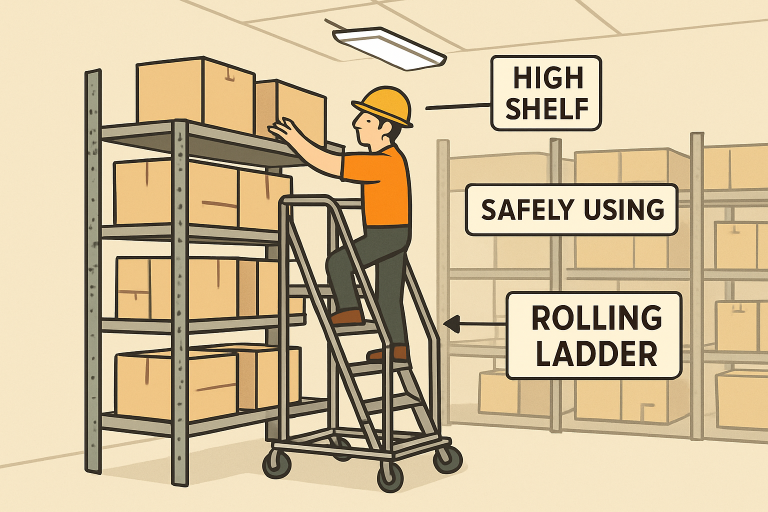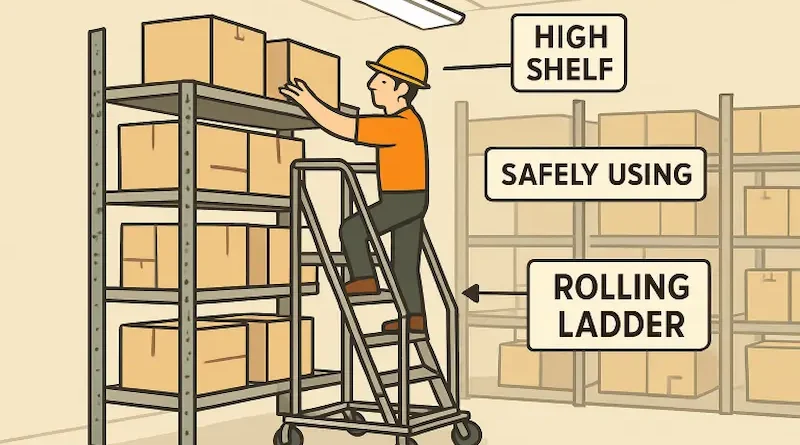Safe Workplace Solutions with Rolling Ladders
Understanding Rolling Ladders
Maintaining a safe and efficient work environment requires the right tools—and rolling ladders are among the most effective solutions for workplaces that handle inventory or storage at heights. These ladders, unlike standard stationary options, feature built-in wheels or casters, enabling easy movement between storage areas. Trusted by warehouses, retail outlets, libraries, and industrial settings, ladders combine ease of access and strong safety features.
Rolling ladders aren’t just limited to storage rooms. Their adaptability enables them to work effectively in various environments, such as manufacturing plants and large offices, streamlining daily tasks safely and efficiently. Designed for repeated use and to support significant weight, these ladders are essential for workplaces aiming to reduce manual handling risks.
Important construction details amplify safety. Many rolling ladders are made from durable steel or lightweight aluminum, and most models provide wide treads and a sturdy working platform with guardrails to prevent falls. This support structure is a major reason why rolling ladders have become a staple in safety-focused operations.
Employers prioritizing employee safety and productivity find rolling ladders indispensable when compared to improvised methods of reaching elevated areas, like standing on chairs or unstable boxes.

Benefits of Using Rolling Ladders
- Enhanced Mobility: Built-in wheels enable employees to easily move ladders from one location to another, eliminating the need for heavy lifting and reducing the risk of injury.
- Stability on Demand: Sliding, tip-overs, and accidental movement are minimized thanks to brake and locking mechanisms that secure the ladder during use.
- Upgraded Safety Features: Non-slip steps and full-length handrails enable confident movement on the ladder, essential for mitigating falls and maximizing safe productivity.
By integrating these ladders, businesses not only speed up workflows but also foster a culture of safety, which leads to fewer workplace injuries and greater job satisfaction among staff.
Compliance with Safety Standards
The Occupational Safety and Health Administration (OSHA) sets clear rules for ladder safety to protect workers against the risks of falls—a leading cause of workplace injuries. Rolling ladders must meet strict guidelines, including the ability to support at least four times the maximum intended load and undergo regular safety inspections. Proper labeling, handrails on ladders with more than three steps, and secured locking wheels or feet are all OSHA requirements for reducing hazards during use.
Regular compliance not only keeps employees safe but also shields businesses from legal repercussions and costly downtime due to injuries or unsafe practices. OSHA recommends conducting routine visual inspections and performing functional tests on all workplace ladders to ensure their safe use.
Recent Innovations in Ladder Safety
Ladder manufacturers continue to innovate with new designs to reduce workplace hazards. One recent development is the introduction of visual safety systems embedded directly onto ladders. These markings and cues help users identify safe positioning and correct orientation at a glance. For example, Werner’s latest ladders feature color-coded warnings and indicators, guiding users to safer practices and reducing the improper use of ladders.
These advances are not purely technological—ergonomic improvements, such as wider steps, more comfortable handrails, and quick-activating brakes, also make a real-world difference in injury prevention.
Proper Usage and Maintenance
- Routine Inspections: Before every use, check the ladder for damage, loose or missing hardware, cracks, or malfunctioning wheels. Replace any parts showing wear, and never use a compromised ladder.
- Training and Signage: Employees should participate in ladder safety training and be familiar with all manufacturer guidelines and regulations. Clear signage can also remind users of ladder weight limits and proper use in high-traffic environments.
- Correct Storage: Always store rolling ladders in a designated, dry, and secure area. Keeping ladders away from chemicals or direct weather exposure prolongs their lifespan and reliability.
Alternatives to Traditional Ladders
While rolling ladders are ideal in many settings, other access solutions may be better suited to specific tasks or environments. For example, mobile work platforms, lift tables, and powered low-level access machines provide stable working surfaces with added ergonomic benefits, especially in areas with frequent up-and-down movement needs or tight spaces.
Industry leaders like JLG offer innovative low-level access systems designed to replace ladders and scaffold systems when workers need extended overhead reach and both hands free for tasks, dramatically improving both safety and efficiency. These solutions are particularly valuable in environments with variable floor heights or where repetitive ladder handling can increase injury risk.
Conclusion
Rolling ladders serve as a cornerstone for safe and efficient access to elevated storage and work areas in today’s demanding workplaces. By prioritizing compliance, ongoing staff training, and embracing both traditional and innovative ladder solutions, organizations can prevent accidents, adhere to regulations, and build safer environments for all employees.
Visit the rest of the site for more interesting and useful articles.

